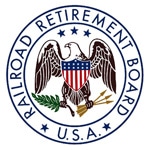
1. What are the eligibility requirements for a supplemental annuity?
Individuals receiving a railroad retirement age and service, or disability annuity, can be paid a monthly supplemental annuity at age 60, if the employee has at least 30 years of creditable railroad service, or at age 65 with at least 25 years of service. (Disabled annuitants under full retirement age, which ranges from age 65 to 67, depending on the year of birth, must relinquish employment rights in order for a supplemental annuity to be paid by the RRB.) A “current connection” with the railroad industry is also required, as is at least one month of creditable rail service before October 1981. The maximum monthly supplemental annuity rate is $43.
2. What effect does the receipt of a private railroad pension have on the payment of a supplemental annuity?
If a retired employee also receives a private pension funded entirely or in part by a railroad employer, the supplemental annuity is permanently reduced by the amount of the monthly pension benefit that is based on the railroad employer’s contributions. However, if the employer reduces the pension for the employee’s entitlement to a supplemental annuity, the amount by which the pension is reduced is restored to the supplemental annuity (but does not raise it over the $43 maximum). There is no reduction for a pension paid by a railroad labor organization.
3. What if an employee elects to receive the pension in a lump-sum payment instead of as a monthly benefit?
If a retired employee elects to receive his or her pension in a lump-sum payment instead of as a monthly benefit, the supplemental annuity is reduced in the same way as it would be if the employee was receiving the monthly benefit. If the lump sum is paid in installments, the installment payments are not considered monthly benefit payments, but part of the single, lump-sum payment.
4. Does the receipt of a 401(k) plan distribution reduce the amount of a supplemental annuity?
No. In Legal Opinion L-2014-2, issued January 13, 2014, the RRB’s General Counsel determined that 401(k) plans should not be considered supplemental pension plans as defined by the Railroad Retirement Act and, therefore, employee supplemental annuities should not be reduced due to the receipt of 401 (k) distributions.
In accordance with the legal opinion, the RRB removed the 401(k) distribution reduction from the supplemental annuities of affected beneficiaries effective January 1, 2014, or the supplemental annuity beginning date, whichever date is later. Refunds of the amounts previously deducted for the 401(k) distribution reduction (beginning on the applicable date above) were issued to those beneficiaries in July 2015.
5. Are employee contributions to a 401(k) plan subject to railroad retirement Tier I and Tier II payroll taxes?
Yes. Federal budget legislation enacted in 1989 and effective January 1, 1990, provided that employee contributions to 401(k) plans are subject to railroad retirement payroll taxes and brought the treatment of 401(k) plans under railroad retirement law into conformity with the treatment of such plans under social security law. Consequently, employee contributions to a 401(k) plan are also treated as creditable compensation for railroad retirement benefit purposes. For example, an employee earning $40,000 a year, but who has 10 percent of his earnings deferred under a 401(k) plan, would have only $36,000 reported to the IRS as earnings subject to Federal income tax. However, the entire $40,000 would be subject to railroad retirement payroll taxes and therefore creditable as compensation under the Railroad Retirement Act.
6. How can a person get more information about the effect of private rail pensions and 401(k) plan payments on supplemental annuities?
Persons can contact an RRB field office for more information via the agency’s website, www.rrb.gov, or by calling toll-free at 1-877-772-5772. Most RRB offices are open to the public from 9:00 a.m. to 3:30 p.m., Monday through Friday, except on Federal holidays.
